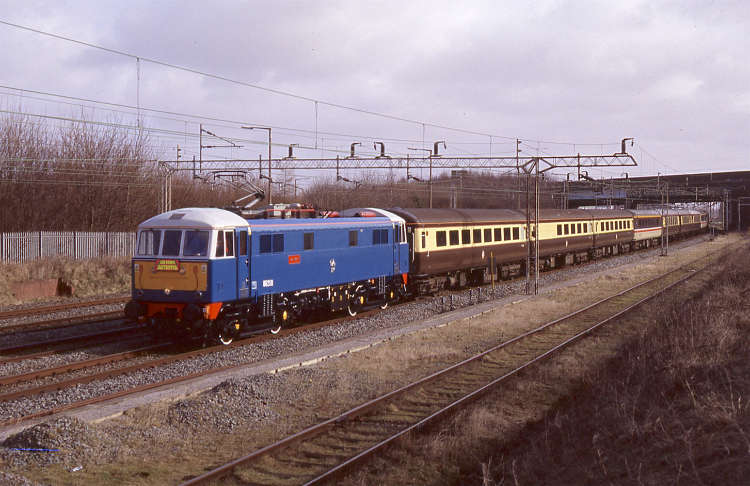
8D ASSOCIATION
The 8D Association is dedicated to promoting the history of the railways of South Lancashire, Merseyside and North Cheshire.
The SH & RGR Warrington Extension.
‘The Low Level’ (Garston to Arpley).

Photograph by David Pool (original image taken on Kodachrome transparency film)
Introduction.
The St Helens and Runcorn Gap Railway obtained the St Helens Railway Act in 1847 to grant the company powers to construct a line from Runcrorn Gap to Warrington Arpley. With Warrington at the time being a major industrial centre of metal working the company could see an opportunity to gain new traffic. The chemical industry in the shape of Joseph Crossfields on the banks of the Mersey was rapidly expanding.
The railway was to burrow under the exiting Grand Junction line at Warrington Bank Quay which had opened on 25th July 1831. After passing under the station at Warrington the railway was to eventually meet end on with the Warrington and Stockport Junction Railway at Arpley.

Photograph by David Pool (original image taken on Kodachrome transparency film)
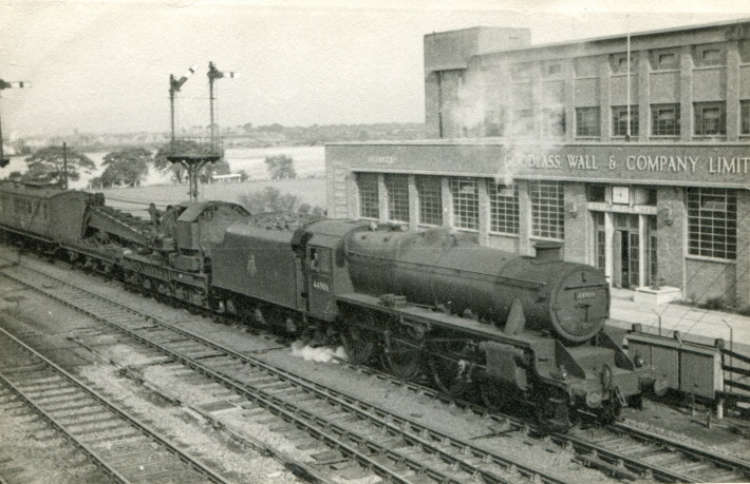
Photographer unknown. (From the Dave Tollit collection).
Construction.
Work started slowly, mainly due to the company concentrating on the completion of the extension to Garston. So in 1851 work finally began on the line. From Runcorn Gap the railway was to follow the Sankey Canal for most of its length. It was upon reaching Sankey Bridges that the railway was to cross the canal and carry on east to Warrington. Work also had to be completed at Warrrington Bank Quay with the main line being raised to allow the SH & RGR to pass underneath it.
Progress with the line was slow but steady and the company hoped to have the line open by the start of the following year. On 1st February 1853 a temporary terminus at Whitecross was opened. It would be over a year before the remaining section to Arpley would open for traffic the line was completed in 1854 but opening was delayed until the W & S was completed. The line finally opened on 24th April 1854 when it was inspected by Captain Wynne and was to be found satisfactory for traffic. Public services were to commence on 1st May 1854 with the joint temporary station at Wilderspool opening from that date.
The railway was to burrow under the exiting Grand Junction line at Warrington Bank Quay which had opened on 25th July 1831. After passing under the station at Warrington the railway was to eventually meet end on with the Warrington and Stockport Junction Railway at Arpley.

Stations
Cuerdley
Opened around March 1856 the station was a result of pressure from local residents for one adjacent to the local bone yard. It was sited east of Carterhouse Junction and was obviously never profitable as it was closed in January 1858. The owners of the SH & RGR sought to ensure that the situation would not arise again were they would be opening an unprofitable station due to the locals wanting one. They placed a level of £ 3 per week minimum income that had to be generated from any future station.

Fidlers Ferry and Penketh.
Opened on 1st February 1853 the station was located at the end of a track leading to the Ferry Inn it was directly adjacent to the Sankey Canal which at the time was still a busy waterway. The station was provided with two platform faces and a small goods yard to the east. Traffic was probably light due to the low population in the area at the time. As with the other intermediate station on the line the passenger service was withdrawn on 2nd January 1950 but passenger trains would continue to use the line to Manchester and Liverpool until they too were withdrawn in September 1962. No trace of the platforms exists today but the station houses directly adjacent to the station are still in use as a private residence. The goods yard is now a car park for the Ferry Inn.
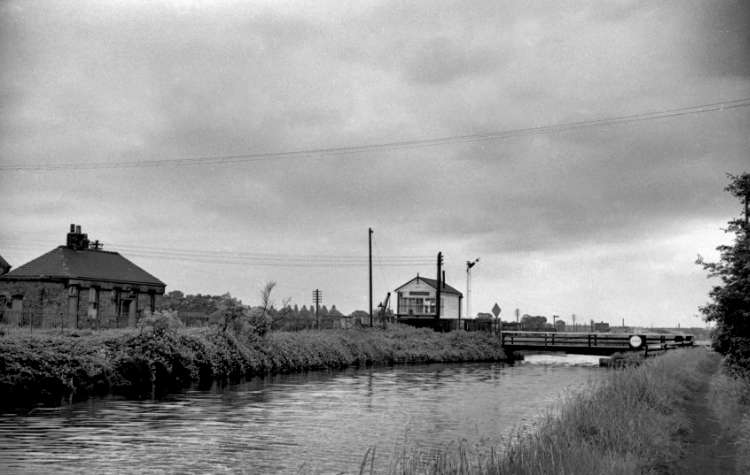
Photo by Harry Arnold MBE / Waterway Images. (View more of Harry’s Waterway Images here )

Photo by Terry Callaghan.
More information on Fidlers Ferry & Penketh Click here
Sankey Bridges.
Opened on 1st February 1853 the station was directly to the west of the canal swing bridge. Unlike Fidlers Ferry the area surrounding it was more populated thus giving higher passenger numbers. The station was closed as a Wartime measure during WW1, like many others, on 1st January 1917 and happily re-opened on 1st July 1919. It had its passenger service withdrawn on 2nd January 1950 and was subsequently closed. Whilst the canal was still in use the swing bridge which was controlled by the signal box situated on the east end of the westbound platform was left open after the final train of the day had run. This practice allowed the canal traffic to pass unhindered and was standard throughout the railways. Unfortunately in November 1858 the bridge was left open, as usual, after the passage of the final booked train when a special light engine working from Garston fell into the canal. The engine was subsequently recovered. Today no trace of the box or the westbound platform remains but the eastbound platform is still visible from the foot crossing to the east of the site. There are also still some railings present to the rear of the platform.

Photo by Terry Callaghan.
More information on Sankey Bridges station click here
Whitecross.
The temporary terminus at Whitecross opened on 1st February 1853 and was used until the opening of the line on 1st May 1854. All traces of the station have been lost under the Lever Brothers works which are still situated in the area. The site of this station has been completely lost with the building works that have occurred in the area we do not believe any pictures exist or that the site of the station can be located.
Warrington Bank Quay Low Level.
Opened by the LNWR on 16th November 1868 and was an interchange station between the ex SH & RGR and the ex Grand Junction line. The possibility of changing between local services and main line should have made this a busy station. It was unfortunate that passenger services were withdrawn from the line on 10th September 1962. Which was probably a short sighted move but with all intermediate stations along the line closed an interchange station such as this one could not be viable. The Night Mail, continued to use the station until 9th September 1963 but the cost of opening the signal boxes along the route for one train on a Sunday saw the train diverted via Earlestown. With this the station finally closed and was completely demolished.

Photographer unknown (1961). From the Les Fifoot collection.
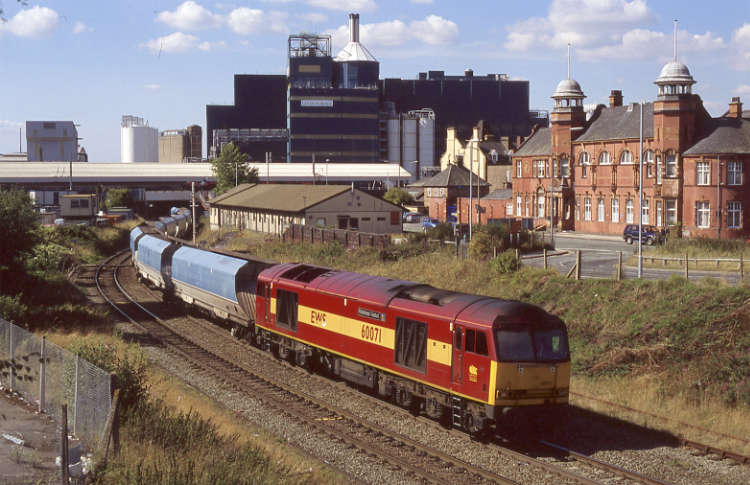
More information on Warrington Bank Quay Low Level station Click here
Warrington Arpley.
The impressive terminus was opened on 1st May 1854 and was a well used centrally located station. The station was not favoured by the LNWR and was closed on 16th November 1868 with the company feeling that passengers should use the Low Level station located nearby. The residents made a legal challenge to the closure and the LNWR was forced to re-open Arpley which it did begrudgingly. The station enjoyed a long life and would finally close to passengers on 15th September 1958 and to goods on 14th June 1965. The station has since been completely demolished and no trace remains.
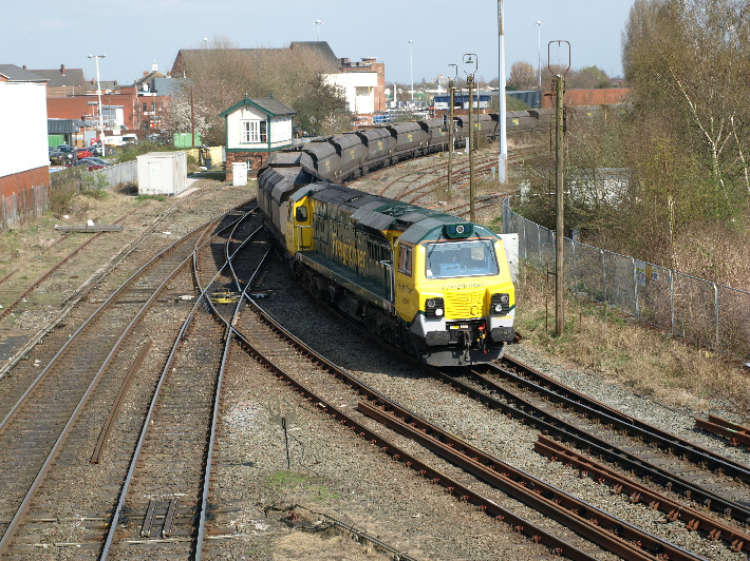
More information on Warrington Arpley station Click here
Fiddlers Ferry Power Station.
What probably saved the line from total closure was the building by the GEGB of Fiddlers Ferry Power Station. The station was to be coal fired and rail connected with an east facing junction in between Fidlers Ferry and Penketh station and Carterhouse junction. The decision to provide an east facing junction only has provided later operational difficulties. The junction was provided facing east as the majority of the coal that was to be consumed by the power station would come from the Yorkshire coalfield and be delivered via the Woodhead route. The trains would simply run via Warrington Low Level into the loop then back out eastbound back to the collieries. In recent years the coal has been imported with the vast majority coming in through Liverpool Bulk Terminal. This now requires trains running via Ditton to pass the power station and reverse at Latchford sidings. The when empty they have to return to Latchford and reverse again to pass the power station once more. Many of the trains have been recently run via the L & M line and the West Coast Main Line. This too involves a reverse at Walton Junction and then again at Latchford sidings with the same happening with an empty train.

Today
The Low Level is still open virtually in its entirety with the line from Carterhouse Junction to Widnes West Deviation Junction being the only section which has closed. The closure of the section was facilitated by the building of the Deviation by the LNWR. The line had been unused for through traffic since the late 1960’s and was then truncated with the section from Carterhouse latterly being used as sidings. These were cut back and used by Tarmac for the delivery of road stone these sidings and the remaining connection from Carterhouse was finally lifted in the late 80’s. Since the 1970’s the traffic flows along the line have declined in line with the decline of the chemical industry in the Widnes and Runcorn area. A new flow in the 70’s was to come from the new BOC plant at Ditton which was to transport many of its products by rail this plant closed in the early 90’s and the traffic was lost. Another loss was the Tanhouse Lane to Earles sidings cement trains which ran until the late 90’s. The twice weekly salt trains from Folly Lane Runcorn to Roche at Dalry also ceased to run around the same time as the cement trains. The development by the O’Connor Group of the ex BOC terminal into an inland port did bring a new flow along the line from Arpley in the form of a twice weekly intermodal train. Since the site was taken over by the Stobart Group it has flourished but the rail traffic has now been diverted by the Ditton to Weaver line. The line use to see numerous deliveries of coal to Fiddlers Ferry Power Station, but since about 2017, there has been just short term flows were arriving from Avonmouth, Redcar and Eggborough PS until mid 2019. Over the three years, Fly Ash has been transported by rail from the Power Station to Kirby Thorpe in Cumbria. On 31st March 2020, the power station officially closed but in the short to medium term, the trains should continue as there is approx 15 years of fly ash still on site to be moved. As for the future of the site, is yet to be decided. West of Fiddlers Ferry traffic is extremely light usually comprising of two light engine movements per day and the occasional train of vans from Halewood to Arpley for cleaning, these workings can often run hours early so catching them can be a real challenge!
